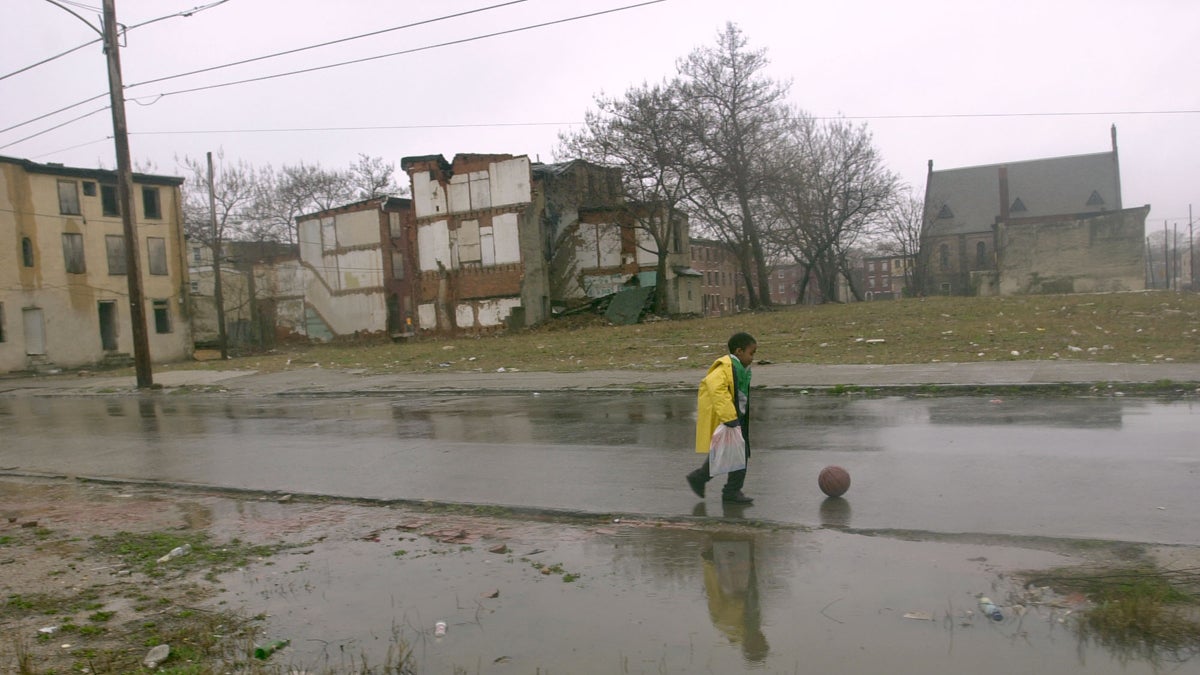What is a land bank?

Michael Witherspoon walks home past abandoned rowhomes and empty lots in north Philadelphia. The 2010 census estimated that Pennsylvania has nearly 400,000 vacant properties, about 20,000 of which are in Pittsburgh and 40,000 in Philadelphia. (AP File Photo/Dan Loh)
One in a series explaining key terms and concepts of Pennsylvania government. Today’s topic: land banks
Seeking a better understanding of Pennsylvania’s issues and proposed solutions? Sometimes, complicated jargon and concepts can get in the way. That’s why we started Explainers, a series that tries to lay out key facts, clarify concepts and demystify jargon. Today’s topic: land banks. Updated December 7, 2015.
Land banks are a tool designed to help local governments return abandoned and tax-delinquent properties in their jurisdictions into productive use. Land banking has been used in the U.S. since the 1970s, but Pennsylvania’s third generation land bank legislation, passed in 2012, includes new provisions to tackle the problems of blight in the state’s communities.
Why are land banks necessary?
The 2010 census estimated that the state has nearly 400,000 vacant properties, about 20,000 of which are in Pittsburgh and 40,000 in Philadelphia. Studies have shown what people who live near abandoned properties already know: that vacant units bring down property values in neighborhoods. Research also suggests that blighted property can increase crime rates in neighborhoods. They cost local governments millions in uncollected property taxes and maintenance costs.
The problem is that it’s time consuming and difficult to identify a property, figure out who owns it, and deal with back taxes. It’s even harder if the property owners can’t be tracked down. Multiply that by thousands of properties and you can see why the process moves so slowly, when it moves at all. A land bank, theoretically, speeds up that process, in effect making neighborhood improvements easier and faster.
How does a land bank work?
According to Pennsylvania’s law, any county, city, borough, township, or town with a population of 10,000 people or more can create and maintain a public agency known as a land bank. The law also allows for the creation of land banks by two or more of these units with populations that fall below 10,000.
The land bank then builds its inventory through donations, purchases, or leases. Its core power is to dissolve any back taxes or tax liens associated with a property in its inventory and put it back on the market with a clear title. Its other major power is to then convey the properties to new owners or developers in a controlled manner, making sure any future use matches what the neighborhood envisions for itself. If, for example, a developer wants to buy a row of blighted houses and replace them with upscale condos but area residents want affordable housing instead, the land bank can choose to sell to someone promising affordable housing, even if it’s a lower bid.
According to Frank Alexander, Cofounder of the Center for Community Progress and Emory University law professor, who helped draft Pennsylvania’s law, redevelopment authorities may, theoretically, be able to perform the duties of the land bank, but the land bank’s narrow focus makes it uniquely equipped to do so efficiently. Liz Hersh, with the Housing Alliance of Pennsylvania, said “the interface between the land bank and the tax sale law is a little bit clearer,” as well.
Land banks can leverage dedicated staff and powers to:
Acquire property by donation, purchase, or lease-purchase agreements from private property owners, government agencies like redevelopment authorities, municipalities, and other entities. The land bank does not, however, have the power of eminent domain
Acquire single properties or parcels of properties at judicial sales and receive them free of tax, municipal, or mortgage claims
Maintain properties it owns in compliance with local ordinances and statutes
Create and maintain a publicly accessible inventory of all its properties
Exchange, sell, transfer, lease, grant, or mortgage its properties
Dissolve tax liens for properties it maintains to make clear title
Establish priorities for future use of properties it owns, including public spaces, affordable housing, retail, commercial and industrial activities, and conservation areas. The land bank has to consider existing land use plans when making those decisions
Funding
Land banks can receive grants and loans from the federal government, the Commonwealth, a municipality, the jurisdiction that created the land bank or private sources. Proceeds from property sales, investments, and the issuance of bonds can also contribute to a land bank’s operating budget. And Pennsylvania law permits land banks to charge for services rendered and to retain for up to five years up to 50-percent of taxes paid on properties it conveys back into productive use.
Where do land banks stand in Pennsylvania?
Several land banks have been established in the Commonwealth since Pennsylvania passed legislation allowing their creation in 2012. The land banks are just getting started and some still lack funding mechanisms. Existing land banks include:
Philadelphia Land Bank
Pittsburgh Land Bank
Westmoreland County Land Bank
Dauphin County Land Bank
Harrisburg Land Bank
Lackawanna County Land Bank
The Philadelphia land bank has started accepting properties, two years after its creation.
More land banks are also being considered. The Erie Redevelopment Authority, Berks County, and a group of several dozen municipalities in Allegheny County are all looking at land banks as a tool to deal with their respective blighted properties.
Check out more of Keystone Crossroads’ coverage of land banks here.
Did this article answer all your questions about Pennsylvania land banks? If not, you can reach Irina Zhorov via email at iZhorov@wesa.fm or through social media @zhorovir. Have a topic on which you’d like us to do an Explainer? Let us know in the comment section below, or on Twitter @PaCrossroads.
WHYY is your source for fact-based, in-depth journalism and information. As a nonprofit organization, we rely on financial support from readers like you. Please give today.


